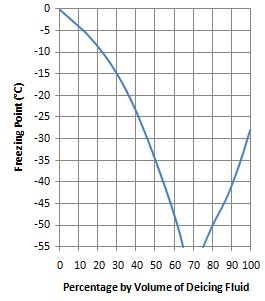Aircraft deicing fluid
Aircraft Deicing Fluid[edit | edit source]
Aircraft deicing fluid is a critical component in the aviation industry, used to remove and prevent the accumulation of ice and snow on the surfaces of aircraft. This process is essential for maintaining the safety and performance of aircraft during winter operations.
Types of Deicing Fluids[edit | edit source]
There are several types of deicing fluids, each with specific properties and uses:
Type I Fluids[edit | edit source]
Type I fluids are primarily used for deicing purposes. They are typically composed of a mixture of glycol and water, with a low viscosity that allows them to be sprayed easily over aircraft surfaces. These fluids are effective at removing ice and snow but offer limited anti-icing protection.
Type II, III, and IV Fluids[edit | edit source]
Type II, III, and IV fluids are designed for anti-icing purposes. They contain thickeners that increase their viscosity, allowing them to adhere to aircraft surfaces and provide extended protection against ice formation. Type IV fluids are the most commonly used for anti-icing due to their superior holdover times.
Composition and Properties[edit | edit source]
Aircraft deicing fluids are primarily composed of propylene glycol or ethylene glycol, mixed with water and various additives. These additives can include corrosion inhibitors, wetting agents, and dyes to improve visibility during application.
Environmental Considerations[edit | edit source]
The use of glycol-based deicing fluids raises environmental concerns due to their potential impact on water quality and wildlife. Airports often implement glycol recovery systems to capture and recycle used deicing fluids, minimizing environmental impact.
Application Techniques[edit | edit source]
Deicing fluids are applied using specialized equipment, such as deicing trucks equipped with booms and nozzles. The application process involves spraying the fluid onto the aircraft surfaces, ensuring complete coverage to remove ice and snow effectively.
Safety and Regulations[edit | edit source]
The use of deicing fluids is regulated by aviation authorities such as the Federal Aviation Administration (FAA) and the European Union Aviation Safety Agency (EASA). These regulations ensure that deicing procedures are conducted safely and effectively, minimizing risks to aircraft operations.
Related Pages[edit | edit source]
Search WikiMD
Ad.Tired of being Overweight? Try W8MD's physician weight loss program.
Semaglutide (Ozempic / Wegovy and Tirzepatide (Mounjaro / Zepbound) available.
Advertise on WikiMD
|
WikiMD's Wellness Encyclopedia |
| Let Food Be Thy Medicine Medicine Thy Food - Hippocrates |
Translate this page: - East Asian
中文,
日本,
한국어,
South Asian
हिन्दी,
தமிழ்,
తెలుగు,
Urdu,
ಕನ್ನಡ,
Southeast Asian
Indonesian,
Vietnamese,
Thai,
မြန်မာဘာသာ,
বাংলা
European
español,
Deutsch,
français,
Greek,
português do Brasil,
polski,
română,
русский,
Nederlands,
norsk,
svenska,
suomi,
Italian
Middle Eastern & African
عربى,
Turkish,
Persian,
Hebrew,
Afrikaans,
isiZulu,
Kiswahili,
Other
Bulgarian,
Hungarian,
Czech,
Swedish,
മലയാളം,
मराठी,
ਪੰਜਾਬੀ,
ગુજરાતી,
Portuguese,
Ukrainian
Medical Disclaimer: WikiMD is not a substitute for professional medical advice. The information on WikiMD is provided as an information resource only, may be incorrect, outdated or misleading, and is not to be used or relied on for any diagnostic or treatment purposes. Please consult your health care provider before making any healthcare decisions or for guidance about a specific medical condition. WikiMD expressly disclaims responsibility, and shall have no liability, for any damages, loss, injury, or liability whatsoever suffered as a result of your reliance on the information contained in this site. By visiting this site you agree to the foregoing terms and conditions, which may from time to time be changed or supplemented by WikiMD. If you do not agree to the foregoing terms and conditions, you should not enter or use this site. See full disclaimer.
Credits:Most images are courtesy of Wikimedia commons, and templates, categories Wikipedia, licensed under CC BY SA or similar.
Contributors: Prab R. Tumpati, MD



